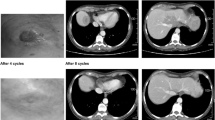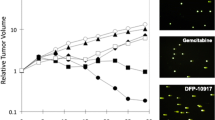Abstract
This paper describes the relationship between 5-fluorouracil (FUra)-derived toxicities and plasma levels of the FUra anabolites 5-fluorouridine (FUrd) and 5-fluoro-2′-deoxyuridine (FdUrd) monitored in patients receiving continuous infusions of FUra (1000 mg/m2 per 24 h) over 5 days preceded by the administration of cisplatin (100 mg/m2). A total of 63 courses of this treatment were given as second-line chemotherapy to 17 patients with metastatic breast cancer. The active FUra anabolites FUrd and FdUrd were monitored twice daily in the plasma by highperformance liquid chromatography. Data were analyzed using multiple analysis of variance (ANOVA). Only a low proportion of patients exhibited measurable plasmatic levels of FUrd (43%) and FdUrd (70%). The areas under the plasma concentration-time curves (AUC) determined over 120 h for FUrd (AUCFUrd) and for FdUrd (AUCFdUrd) were found to be statistically significantly different for chemotherapy cycles with and those without myelosuppression. Chemotherapy cycles without neutropenia were associated with low AUCFUrd values (mean±SEM, 2.9±0.7 μg ml−1 h) and high AUCFdUrd values (14.1±2.7 μg ml−1 h), respectively, whereas courses with myelosuppression (WHO grades 2–4) showed inverse profiles with high AUCFUrd values (16.3±2.3 μg ml−1 h) and low AUCFdUrd values (3.1±1.0 μg ml−1 h), respectively. A statistically significant difference in AUCFdUrd values was also observed between cycles with and those without mucositis (P=0.0027), with AUCFdUrd values being 22.6±5.6 and 7.8±1.9 μg ml−1 h, respectively. Whereas hematotoxicity could be correlated with both AUCFUrd and AUCFdUrd values, mucositis was associated with high AUCFdUrd levels. Moreover, a negative correlation was found between the AUCs determined for FUrd and FdUrd (P=0.002), indicating that activation of FUra via FUrd or via FdUrd may involve competitive processes. Therefore, to follow the development of the major FUra-derived toxicities, measurement of FUrd and FdUrd plasma levels appeared very attractive.
Similar content being viewed by others
References
Barberi-Heyob M, Merlin JL, Weber B (1992) Determination of 5-fluorouracil and its main metabolites in plasma by high-performance liquid chromatography. J Chromatogr Biomed Appl 573: 247
Chaudhuri NK, Mukherjee KL, Heidelberger C (1958) Studies on fluorinated pyrimidines. Biochem Pharmacol 1: 328
De Bruijn EA, Van Oosterom AT, Tjaden UR (1989) Site-specific delivery of 5-fluorouracil with 5-deoxy-5-fluorouridine. Regul Cancer Treat 2: 61
Ensminger WD, Resousky A, Leven DC, Glode M (1978) A clinical pharmalogical evaluation of hepatic arterial infusions of 5-fluoro-2′-deoxyuridine and 5-fluorouracil. Cancer Res 38: 3784
Finan PJ, Chisholm EM, Woodhouse L, Giles GR (1987) The relationship between plasma pharmacokinetics and tissue metabolites of 5-fluorouracil (FUra) in patients with colorectal cancer. Eur J Surg Oncol 13: 349
Fleming RA, Milano GA, Gaspard MH, Bargnoux PJ, Thyss A, Plagne R, Renée N, Schneider M, Demard F (1993) Dihydropyrimidine dehydrogenase activity in cancer patients. Eur J Cancer 29: 740
Goldberg JA, Kerr DJ, Willmott N, McKillop JH, McArdle CS (1988) Pharmacokinetics and pharmacodynamics of locoregional 5-fluorouracil. Br J Cancer 57: 186
Hara Y, Kono A (1984) Enzymatic conversion of 5′-deoxy-5-fluorouridine (5′-DFUR) and tegafur to 5-fluorouracil (5-FU) in human tumor tissue. In: Kimura K, Fujii S, Ogawa M, Bodey GP, Alberto P (eds) Fluoropyrimidines in cancer therapy. Elsevier, Amsterdam, pp 80–92
Harrisson SD, Denine EP, Peckham JC (1978) Qualitative and quantitative toxicity of single and sequential sublethal doses of 5-fluorouracil in BDF1 mice. Cancer Treat Rep 62: 533
Hillcoat BL, McCulloch PB, Figueredo AT, Ehsan MH, Rosenfeld JM (1978) Clinical response and plasma levels of 5-fluorouracil in patients with colonic cancer treated by drug infusion. Br J Cancer 38: 719
Houghton JA, Houghton PJ, Wooten RS (1979) Mechanism of induction of gastrointestinal toxicity in the mouse by 5-fluorouracil, 5-fluorouridine, and 5-fluoro-2-deoxyuridine. Cancer Res 39: 2406
Kies MS (1982) Fluorouracil for colorectal cancer: a sobering look. JAMA 247: 2826
Kish J, Brelichman A, Jacobs J, Hoschner J, Kinzie J, Loh J, Weaver A, Al-Sarraf M (1982) Clinical trial of cisplatin and FUra infusion as initial treatment for advanced squamous cell carcinoma of the head and neck. Cancer Treat Rep 66: 471
Kubota T, Fujita S, Kodaira S (1991) Antitumor activity of fluoropyrimidines and thymidylate synthetase inhibition. Jpn J Cancer Res 82: 476
Lokich JJ, Bothe A, Fine N (1981) Phase I study of protracted venous infusion of 5-fluorouracil. Cancer 48: 2565
Malet-Martino MC, Armand JP, Lopez A, Bernadou J, Béteile JP, Bon M, Martino R (1986) Evidence for the importance of 5′-deoxy-5-fluorouridine catabolism in humans from 19F nuclear magnetic resonance spectrometry. Cancer Res 46: 2105
Malet-Martino MC, Martino R, Armand JP (1990) La spectroscopie de résonance magnétique nucléaire du fluor-19: un outil privilégié pour l'étude du métabolisme et de la pharmacocinétique des fluoropyrimidines. Bull Cancer (Paris) 77: 1223
Milano G, Roman P, Khater R, Frenay M, Renee N (1988) Dose versus pharmacokinetics for predicting tolerance to 5-day continuous infusion of FUra. Int J Cancer 41: 537
Nase-Hijazi B, Berger MR, Schmähl D, Schlag P, Hull WE (1991) Locoregional administration of 5-fluoro-2′-deoxyurindine (FdUrd) in Novikoff hepatoma in the rat: effects of dose and infusion time in tumor growth and on FdUrd metabolite levels in tumor tissue as determined by 19F NMR spectroscopy. J Cancer Res Clin Oncol 117: 295
Pinedo HM, Peters GF (1988) Fluorouracil: biochemistry and pharmacology. J Clin Oncol 6: 1653
Priest DG, Ledford BE (1980) Increased thymidylate synthetase in 5-fluorodeoxyuridine resistant cultured hepatoma cells. Chem Pharmacol 29: 1549
Santini J, Milano G, Thyss A, Renée N, Viens P, Ayela P, Schneider M, Demard F (1989) FUra therapeutic monitoring with dose adjustment leads to an improved therapeutic index in head and neck cancer. Br J Cancer 59: 287
Seifert P, Baker LH, Reed ML, Vaikevicius VK (1975) Comparison of continuously infused 5-fluorouracil with bolus injection in treatment of patients with colorectal carcinoma. Cancer 36: 123
Seitz JF, Cano JP, Rigault JP, Aubert C, Carcassonne Y (1983) Chimiotherapie des cancers digestifs étendus par le fluorouracile: relations entre la réponse clinique et la clairance plasmatique du médicament. Gastroenterol Clin Biol 7: 374
Sobrero AF, Moir RD, Bertino J, Handschumacher RE (1985) Defective facilitated diffusion of nucleosides, a primary mechanism of resistance to 5-fluoro-2′-deoxyuridine in the HCT-8 human carcinoma. Cancer Res 45: 3155
Spears C, Gustavson B, Mitchel MS, Spicer D (1984) Thymidylate synthetase inhibition in malignant tumours and normal liver in patients given bolus intravenous 5-fluorouracil. Cancer Res 44: 4144
Stein TA, Burns GP, Bailey B, Wise L (1990) Measurement of 5-fluorouracil and its active metabolites in tissue. J Chromatogr 507: 259
Stein TA, Bailey B, Burns GP (1990) Comparison of 5-fluorouracil anabolite levels after intravenous bolus and continuous infusion. Cancer Chemother Pharmacol 34: 293
Thyss A, Milano G, Renée N, Vallicioni J, Schneider M (1986) Clinical pharmacokinetic study of FUra in continuous 5-day infusion for head and neck cancer. Cancer Chemother Pharmacol 16: 64
Trump DL, Egorin MJ, Forrest A, Willson JKV, Remick S, Tutsch KD (1991) Pharmacokinetic and pharmacodynamic analysis of fluorouracil during 72-hour continuous infusion with or without dypiridamole. J Clin Oncol 9:2027
Tseng WC, Medena D, Randerath K (1978) Specific inhibition of RNA methylation and modification in tissues of mice treated with 5-fluorouracil. Cancer Res 38: 1250
Van Groeningen CS, Pinedo HM, Heddes J (1988) Pharmacokinetics of 5-fluorouracil assessed with a sensitive mass spectrometric method in patients on a dose escalation schedule. Cancer Res 48: 6956
Vogelzang NJ (1984) Continuous infusion chemotherapy: a critical review. J Clin Oncol 2: 1289
WHO (1980) Handbook for reporting results of cancer treatment. Neoplasia 27: 607
Wolf W, Present CA, Servis KL, EI-Tahtawry A (1990) Tumor trapping of 5-fluorouracil: in vivo 19F NMR spectroscopic pharmacokinetics in tumor—bearing humans and rabbits. Proc Natl Acad Sci USA 87: 492
Yoshida T, Araki E, Ligo M, Shimada Y, Saito D, Tajiri H, Yamaguchi H, Yoshida S, Yoshino M, Ohkura H, Yoshimori M, Okazaki N (1990) Clinical significance of monitoring serum levels of 5-fluorouracil by continuous infusion in patients with advanced colonic cancer. Cancer Chemother Pharmacol 26: 352
Author information
Authors and Affiliations
Rights and permissions
About this article
Cite this article
Barberi-Heyob, M., Weber, B., Merlin, J.L. et al. Evaluation of plasma 5-fluorouracil nucleoside levels in patients with metastatic breast cancer: relationships with toxicities. Cancer Chemother. Pharmacol. 37, 110–116 (1995). https://doi.org/10.1007/BF00685637
Received:
Accepted:
Issue Date:
DOI: https://doi.org/10.1007/BF00685637




